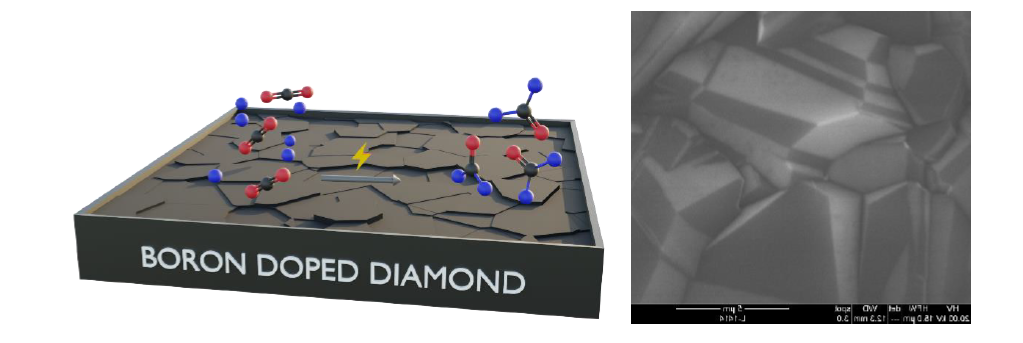MASTER ASSIGNMENT: CO2 ELECTRO-REDUCTION TO PLATFORM CHEMICALS
One necessary step towards net-zero CO2 emissions and carbon circularity is to use captured CO2 as feedstock to produce chemicals or fuels via electrochemical conversion. The technologies to produce the necessary green electricity are being scaled up and becoming more and more economically competitive as we speak.
In this master assignment you will study the CO2 Reduction Reaction (CO2RR) to produce formaldehyde, which is a key platform chemical used a precursor to produce e.g. artificial sugars (Figure 1). The electrode material we will use is polycrystalline Boron Doped Diamond (BDD), which has recently been shown to be a promising candidate for the CO2RR with good selectivity to formaldehyde (Figure 2) [1,2]. Its physicochemical properties, such as the level of boron doping and the size of the crystallites, have been shown to influence product formation rate and selectivity.

Figure 1 (left): Schematic of CO2RR to formaldehyde. Figure 2 (right): Electron microscope image of BDD (unpublished results).
Your goal in this master project is to identify and understand the influence of BDD material parameters on the selectivity towards formaldehyde, with the aim of maximizing the selectivity. To achieve this, you will learn how to operate an electrochemical flow cell reactor and optimize process conditions – that is, to perform electrochemical experiments such as cyclic voltammetry or chronoamperometry to assess the electrochemical behavior of different types of BDD electrodes. The products will be identified and quantified using various types of chromatography. The results of the chromatography analysis will be combined to obtain the faradaic efficiencies towards each product.
This work is part of a Dutch-German research consortium [3], which will allow you to establish contacts on the academic as well as industrial side of this research field and start building a network for your future career.
Contacts
In case you have any questions, feel free to contact Lasse Wichmann and Marco Altomare: Daily supervisor: Lasse Wichmann l.f.wichmann@utwente.nl (Meander Room 147) Supervisor: Prof. Marco Altomare m.altomare@utwente.nl
References
[1] Nakata, K., Ozaki, T., Terashima, C., Fujishima, A. and Einaga, Y. (2014), High-Yield Electrochemical Production of Formaldehyde from CO2 and Seawater†. Angew. Chem. Int. Ed., 53: 871-874. https://doi.org/10.1002/anie.201308657
[2] Julie V. Macpherson (2014) A practical guide to using boron doped diamond in electrochemical research. Phys. Chem. Chem. Phys., 17: 2935-2949 https://doi.org/10.1039/C4CP04022H
[3] Press Release: Five projects starting in Dutch-German programme on green chemistry | NWO
